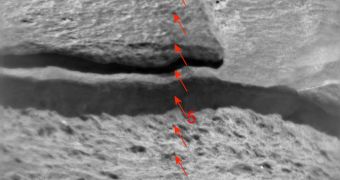Mission controllers at the NASA Jet Propulsion Laboratory (JPL), in Pasadena, California announce that the laser aboard the Mars Science Laboratory (MSL) rover Curiosity has recently topped 100,000 firings on the surface of Mars.
The device is actually a part of the Chemistry and Camera complex (ChemCam) suite of remote sensing instruments, located on the robot's mast. ChemCam consists of the laser-induced breakdown spectroscopy (LIBS) tool and the Remote Micro Imager (RMI) telescope.
LIBS can vaporize rock samples located up to 7 meters (23 feet) away from the rover, via 50- to 75 5-nanosecond pulses of laser light, emitted at 1067 nanometers. Once the laser produces a small puff of material, the RMI telescope is used to peer through these pieces of debris, and analyze their chemical make-up.
JPL investigators say that the laser achieved its 100,000th zap during a burst of 300 firings that occurred in late October, as the rover was analyzing a series of locations on a rock called Ithaca. The object was located 4.04 meters (13 feet and 3 inches) away from ChemCam at the time.
The team explains that the infrared laser on LIBS works by creating clouds of ionized gas called plasma from very tiny points on the surfaces of rocks, outcrops and other scientific targets. In order to get accurate results, multiple locations on the same object are analyzed.
“Passing 100,000 laser shots is terribly exciting and is providing a remarkable set of chemical data for Mars,” explains researcher Horton Newsom, who is based at the University of New Mexico in Albuquerque. He is one of the co-investigators for the ChemCam instrument.
By December 1, Curiosity's laser had already fired 102,000 times, during analyses of around 420 target locations. Each point of interest on a target is usually zapped around 30 times. The spectra thus obtained are relayed to the Mars Reconnaissance Orbiter overhead, for transmission to Earth.
Target “materials include dust, wind-blown soil, water-lain sediments derived from the crater rim, veins of sulfates and igneous rocks that may be ejecta from other parts of Mars,” Newsom goes on to say.
The remote microimager camera has thus far produced in excess of 1,600 images, and researchers have yet to fully decipher all of them. In fact, it is possible that scientists will spend a few years to understand and build theories upon the vast wealth of data that Curiosity sends from Mars.
The rover operates a suite of 10 scientific instruments, all of which produce a lot of data.

 14 DAY TRIAL //
14 DAY TRIAL //